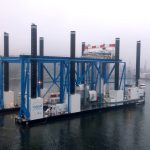The road construction along the coast of the French island La Réunion involves a 5.5 km long viaduct. For this task Polish shipyard Crist is building
a very special jack-up barge.
On the Island La Réunion, a French overseas territory close to Madagaskar, the road between the capital city Saint Denis[ds_preview] and La Possession is running along a cliff’s foot on the north side of the island. La Réunion is periodically hit by cyclones, bringing heavy rain and waves that often cause massive landslides and rockfall, forcing closure of the road again and again. In the face of growing traffic, this is becoming a problem for the volcanic island with a polutation of 850,000. Now, a »New Coastal Highway« is being built – 12km of road, 300m away from the cliff of which 5.5km will be built in the Indian Ocean. This means the project encompasses the construction of a viaduct elevated 20 to 30m above sea level with two lanes for each direction of traffic. Additionally it will have a lane for pedestrians and cyclists as well as a bus lane. The construction is being carried out by the French Viaduct du Littoral consortium, consisting of VINCI Construction subsidiaries VINCI Construction Grands Projets, which acts as lead company, Dodin Campenon Bernard, Demathieu Bard and Bouygues Construction subsidiary Bouygues Travaux Publics, which have considerable experience in large infrastructure projects. The construction of just the viaduct will cost about 715mill. €.
For building the viaduct, between the two abutments at the ends, 48 cylindrical concrete piers have to be set on the seabed, each 20 to 23m in diameter. For each bridge segment first a foundation footing and the lower part of the pier shaft will be set, then followed by the upper part of the pier shaft and a header. On top will sit a section of deck vertical to the pier called a mega segment, consisting of several deck segments itself. The heaviest parts weigh up to 4,800t for the base plates, 2,300t for the pier heads and 2,400t for the mega segments.
The barge
For this task the French consortium ordered a special purpose built jack-up-vessel with Polish shipyard Crist in November 2014. The overall cost is ca. 90mill. $. In January 2015 the construction started. It will be transported to La Réunion by a semi-submersible vessel and is expected to lay the first bridge elements in the second quarter of 2016.
The new vessel named »Zourite« is 107m long and 44m wide and is considered the key element in the construction of the viaduct. The barge’s eight legs were delivered by the Dutch company Ravestein and are equipped with Ravestein’s Continuous Jacking Systems, providing 4,000t of lifting capacity for each of the legs. The new system allows a jacking speed of up to a maximum of 40m/h. The legs’ dimensions are 55m in height with a diameter of 3m and a spudcan of 25m2.
»Zourite« is able to lift up to 4,800t with its two 2,400t over head travel cranes (OHTC), designed and delivered by the Dutch subsidiary of manufacturer Enerpac. The cranes work in a height of 33m above the deck. Lifting Speed is up to 100cm/min without load and up to 40cm/min when loaded. The operational depth is up to 17m. The barge is also equipped with its own slurry and concrete mix plants.
Propulsion is provided by four azimuth thrusters from German manufacturer Schottel, each delivering 900 kW of power. The vessel has DP1 capability and its top speed is 3.5kn. The barge is powered through a diesel-electric set-up with four main engines. NRL appointed Vinci Energies’ France subsidiary Barillec Marine to supply the energy production and electric propulsion equipment. This also includes a power management system and switchboards as well as DP and bridge systems, communications and controls. Total electrical power output is 5 MW.
Experienced shipyard
»Zourite« is not the first jack-up barge Crist is building. The Polish shipyard has become an expert in the construction of jack-up barges and vessels over the past years and was chosen by NRL from a group of international competitors for the current project. Crist also built the self-propelled jack-up barge »Thor« for German construction company Hochtief (current owner GeoSea) as well as the installation and heavy maintenance jack-up vessel »Vidar« which was also ordered by Hochtief and later sold to Jan de Nul Group. Also GeoSea’s HLJV »Innovation« was built in Gdynia. The new barge »Zourite« was designed by Polish naval architect StoGda, which has a history of cooperation with the Crist shipyard on various projects.
The prefabrication area for the piers and deck segments is located at Port East. It consists of four production lines, two for the production of the base plates and two for the pier heads. To enable the loading and transport of the pier elements, a 100m long loading wharf was constructed. On the production lines, the parts are moved and loaded onto the barge by successive displacement on air cushions, using push rams. If everything goes according to schedule, »Zourite« will install the 150 heaviest prefabricated elements over a period of 24 months, taking into account the foreseeable worst-case sea and weather conditions. In case of cyclones, the barge will return to Port East and will be able to secure itself by making use of its jacking capability.
Finishing of the first phase of the project is expected in 2018, the complete highway will be completed in 2020. It will then be France’s longest offshore viaduct.
Felix Selzer





















